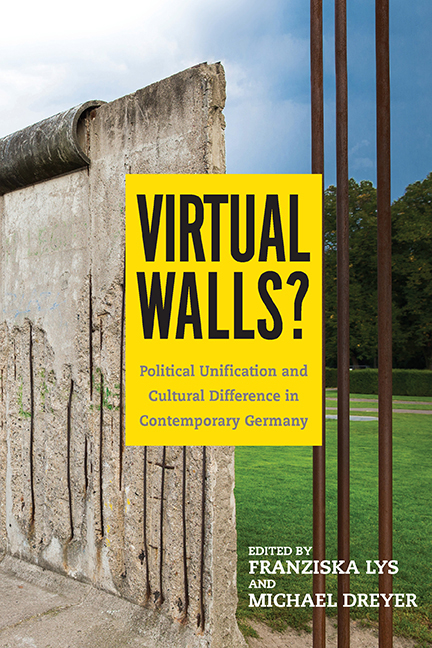Book contents
- Frontmatter
- Dedication
- Contents
- Acknowledgments
- Introduction: United Politics—Divided Culture?
- Part I What Remains: History and the Constitution
- Part II What and How Do We Remember? Literature, Film, and Exhibitions
- Part III A Changing Reception: Painting, Orchestras, and Theaters
- 6 Reexamining the Staatskünstler Myth: Bernhard Heisig and the Post-Wall Reception of East German Painting
- 7 East German Orchestras and Theaters: The Transformation since the Wende
- Part IV A Virtual Wall? Education and Society
- Epilogue: The Wende and the End of “the German Problem”
- Notes on the Contributors
- Index
7 - East German Orchestras and Theaters: The Transformation since the Wende
from Part III - A Changing Reception: Painting, Orchestras, and Theaters
Published online by Cambridge University Press: 24 August 2019
- Frontmatter
- Dedication
- Contents
- Acknowledgments
- Introduction: United Politics—Divided Culture?
- Part I What Remains: History and the Constitution
- Part II What and How Do We Remember? Literature, Film, and Exhibitions
- Part III A Changing Reception: Painting, Orchestras, and Theaters
- 6 Reexamining the Staatskünstler Myth: Bernhard Heisig and the Post-Wall Reception of East German Painting
- 7 East German Orchestras and Theaters: The Transformation since the Wende
- Part IV A Virtual Wall? Education and Society
- Epilogue: The Wende and the End of “the German Problem”
- Notes on the Contributors
- Index
Summary
A Unique Heritage
THE THEATRICAL AND ORCHESTRAL landscape in Germany is unique. There are 131 professional, permanently staffed, publicly financed orchestras: 83 theater orchestras for operas, operettas, and musicals playing in state and municipal theaters; 29 concert orchestras performing in concert halls; 7 publicly funded chamber orchestras; as well as 12 radio or radio symphony orchestras (Mertens 2014). This listing does not include the many professional chamber orchestras and ensembles in Germany, which play on a project-to-project basis, often employing freelance musicians. Germany has—relative to its population and compared to other countries worldwide—the highest density and diversity of symphony and chamber orchestras. Every year, around 35 million people attend more than 120,000 performances of plays and operas, as well as 9,000 concerts. The uniqueness of Germany's theatrical and orchestral landscape was officially recognized in December 2014 by UNESCO as an “intangible cultural heritage of humanity” (“Germany's ‘Orchestral Landscape’” 2014). Yet this cultural treasure is in danger.
Shortly after the Wende, Germany had 168 publicly financed concert, opera, chamber, and radio orchestras (“Germany's ‘Orchestral Landscape’” 2014). Since then, following a period of economic readjustment primarily in the former Eastern parts, 37 ensembles have been dissolved or have merged with other orchestras. This trend is still continuing. For example, in 2016–17 the Stuttgart Radio Symphony Orchestra merged with the Freiburg Symphony Orchestra, with the new orchestra residing in Stuttgart. Some eighty positions were lost through the merger (Mertens 2014b).
Music, as performed by orchestras and opera companies, is different from art and literature. A painting just needs a wall to hang on. For a book, even less is required: just a bit of space on a shelf. But classical music is expensive; it requires a large number of musicians and technical personnel to perform it. Costs are rising, while audiences are dwindling, especially in the east German states. The Cologne musicologist Arnold Jacobshagen (2000, 13–24) published a study on the “structural change in the orchestral landscape,” and I will update that study, following his methodological assumptions. Unlike Jacobshagen, however, I will focus exclusively on East Germany—by now, of course, a geographical and no longer a political designation.
- Type
- Chapter
- Information
- Virtual Walls?Political Unification and Cultural Difference in Contemporary Germany, pp. 131 - 142Publisher: Boydell & BrewerPrint publication year: 2017

